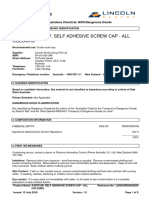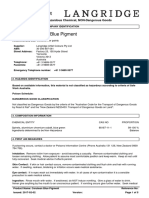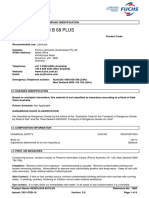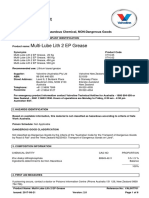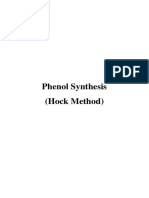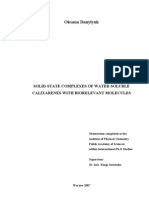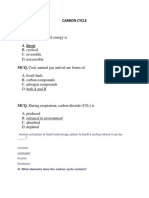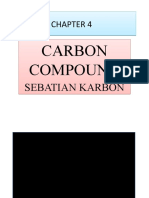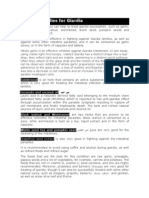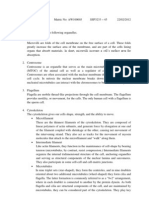Waytac Oil No 68 - Equivalent
Waytac Oil No 68 - Equivalent
Uploaded by
Popo AfiqahCopyright:
Available Formats
Waytac Oil No 68 - Equivalent
Waytac Oil No 68 - Equivalent
Uploaded by
Popo AfiqahOriginal Title
Copyright
Available Formats
Share this document
Did you find this document useful?
Is this content inappropriate?
Copyright:
Available Formats
Waytac Oil No 68 - Equivalent
Waytac Oil No 68 - Equivalent
Uploaded by
Popo AfiqahCopyright:
Available Formats
Safety Data Sheet
NON-Hazardous Substance, NON-Dangerous Goods
1. MATERIAL AND SUPPLY COMPANY IDENTIFICATION
Product name: Hydraulic Oil AW 68
Synonyms: Mancode
Hydraulic Oil AW 68 1281
Recommended use: Antiwear hydraulic lubricant
Supplier: Caltex Australia Petroleum Pty Ltd
ABN: 17 000 032 128
Street Address: 2 Market Street
Sydney NSW 2000
Australia
Telephone: +612 9250-5000
Facsimile: +612 9250-5742
Emergency telephone number: 1800 033 111
2. HAZARDS IDENTIFICATION
Based on available information, this material is not classified as hazardous according to criteria of Safe
Work Australia.
Poisons Schedule (Aust): Not applicable
DANGEROUS GOODS CLASSIFICATION
Not classified as Dangerous Goods by the criteria of the “Australian Code for the Transport of Dangerous
Goods by Road & Rail” and the “New Zealand NZS5433: Transport of Dangerous Goods on Land”.
3. COMPOSITION INFORMATION
CHEMICAL ENTITY CAS NO. PROPORTION
Ingredients determined to be non-hazardous - 100%
________
100%
4. FIRST AID MEASURES
If poisoning occurs, contact a doctor or Poisons Information Centre (Phone Australia 131 126, New Zealand
0800 764 766).
Inhalation: Remove victim from exposure - avoid becoming a casualty. Remove contaminated clothing and
loosen remaining clothing. Allow patient to assume most comfortable position and keep warm. Keep at rest
until fully recovered. Seek medical advice if effects persist.
Skin contact: If skin or hair contact occurs, remove contaminated clothing and flush skin and hair with
running water. If swelling, redness, blistering or irritation occurs seek medical assistance.
Product name: Hydraulic Oil AW 68 Substance Key: CAL0005801
Issued: 18 April 2012 Version: 1.0 Page: 1 of 6
Safety Data Sheet
Eye contact: If in eyes wash out immediately with water. In all cases of eye contamination it is a sensible
precaution to seek medical advice.
Ingestion: Rinse mouth with water. If swallowed, do NOT induce vomiting. Give a glass of water to drink.
Never give anything by the mouth to an unconscious patient. If vomiting occurs give further water. Seek
medical advice.
PPE for First Aiders: Wear overalls, safety glasses and impervious gloves. Available information suggests
that gloves made from nitrile rubber should be suitable for intermittent contact. However, due to variations
in glove construction and local conditions, the user should make a final assessment. Always wash hands
before smoking, eating, drinking or using the toilet. Wash contaminated clothing and other protective
equipment before storing or re-using. If risk of inhalation of exists, wear organic vapour/particulate
respirator meeting the requirements of AS/NZS 1715 and AS/NZS 1716.
Notes to physician: Treat symptomatically.
5. FIRE-FIGHTING MEASURES
Hazchem Code: Not applicable.
Suitable extinguishing media: If material is involved in a fire use water fog (or if unavailable fine water
spray), foam, dry agent (carbon dioxide, dry chemical powder).
Specific hazards: Combustible material.
Fire fighting further advice: On burning may emit toxic fumes. Fire fighters to wear self-contained
breathing apparatus and suitable protective clothing if risk of exposure to vapour or products of combustion.
6. ACCIDENTAL RELEASE MEASURES
SMALL SPILLS
Wear protective equipment to prevent skin and eye contamination. Avoid inhalation of vapours. Wipe up
with absorbent (clean rag or paper towels). Collect and seal in properly labelled containers or drums for
disposal.
LARGE SPILLS
Prevent further leakage or spillage if safe to do so. Slippery when spilt. Avoid accidents, clean up
immediately. Wear protective equipment to prevent skin and eye contamination and the inhalation of
vapours. Work up wind or increase ventilation. Contain - prevent run off into drains and waterways. Use
absorbent (soil, sand or other inert material). Collect and seal in properly labelled containers or drums for
disposal. If contamination of sewers or waterways has occurred advise local emergency services.
Dangerous Goods – Initial Emergency Response Guide No: Not applicable.
7. HANDLING AND STORAGE
Handling: Avoid eye contact and repeated or prolonged skin contact.
Storage: Store in a cool, dry, well-ventilated place and out of direct sunlight. Store away from incompatible
materials described in Section 10. Keep containers closed when not in use - check regularly for leaks.
Product name: Hydraulic Oil AW 68 Substance Key: CAL0005801
Issued: 18 April 2012 Version: 1.0 Page: 2 of 6
Safety Data Sheet
8. EXPOSURE CONTROLS AND PERSONAL PROTECTION
National occupational exposure limits:
No value assigned for this specific material by Safe Work Australia or Department of Labour New Zealand.
Biological Limit Values: As per the “National Model Regulations for the Control of Workplace Hazardous
Substances (Safe Work Australia)” the ingredients in this material do not have a Biological Limit Allocated.
Engineering measures: Natural ventilation should be adequate under normal use conditions. Keep
containers closed when not in use.
Personal protection equipment: OVERALLS, SAFETY SHOES, SAFETY GLASSES, GLOVES.
When handling individual retail packs no personal protection equipment is required. Wear overalls, safety
glasses and impervious gloves. Available information suggests that gloves made from nitrile rubber should
be suitable for intermittent contact. However, due to variations in glove construction and local conditions,
the user should make a final assessment. Always wash hands before smoking, eating, drinking or using the
toilet. Wash contaminated clothing and other protective equipment before storing or re-using.
Hygiene measures: Keep away from food, drink and animal feeding stuffs. When using do not eat, drink or
smoke. Wash hands prior to eating, drinking or smoking. Avoid contact with clothing. Avoid eye contact
and repeated or prolonged skin contact. Ensure that eyewash stations and safety showers are close to the
workstation location.
9. PHYSICAL AND CHEMICAL PROPERTIES
Form / Colour / Odour: Brown liquid with petroleum odour
Solubility: Insoluble in water
Specific Gravity (15 °C): 0.88
Relative Vapour Density (air=1): >1
Vapour Pressure (37.8 °C): <0.01 mmHg
Flash Point (°C): >150 (CC)
Flammability Limits (%): N Av
Autoignition Temperature (°C): N Av
Melting Point/Range (°C): <-6
Boiling Point/Range (°C): >350
pH: N App
o o
Viscosity: 65 cSt @ 40 C; 8.6 cSt @ 100 C
Total VOC (g/Litre): N Av
(Typical values only - consult specification sheet)
N Av = Not available N App = Not applicable
10. STABILITY AND REACTIVITY
Reactivity: No reactivity hazards are known for the material.
Chemical stability: This material is thermally stable when stored and used as directed.
Hazardous reactions: No known hazardous reactions.
Conditions to avoid: Elevated temperatures and sources of ignition.
Product name: Hydraulic Oil AW 68 Substance Key: CAL0005801
Issued: 18 April 2012 Version: 1.0 Page: 3 of 6
Safety Data Sheet
Incompatible materials: Oxidising agents.
Hazardous decomposition products: Oxides of carbon and nitrogen, smoke and other toxic fumes.
11. TOXICOLOGICAL INFORMATION
No adverse health effects expected if the product is handled in accordance with this Safety Data Sheet and
the product label. Symptoms or effects that may arise if the product is mishandled and overexposure occurs
are:
Acute Effects
Inhalation: Material may be an irritant to mucous membranes and respiratory tract.
Skin contact: Contact with skin may result in irritation.
Ingestion: Swallowing can result in nausea, vomiting and irritation of the gastrointestinal tract.
Eye contact: May be an eye irritant.
Acute toxicity
Inhalation: This material has been classified as non-hazardous. Acute toxicity estimate (based on
ingredients): >20 mg/L.
Skin contact: This material has been classified as non-hazardous. Acute toxicity estimate (based on
ingredients): >2,000 mg/Kg.
Ingestion: This material has been classified as non-hazardous. Acute toxicity estimate (based on
ingredients): >2,000 mg/Kg.
Corrosion/Irritancy: Eye: this material has been classified as not corrosive or irritating to eyes. Skin: this
material has been classified as not corrosive or irritating to skin.
Sensitisation: Inhalation: this material has been classified as not a respiratory sensitiser. Skin: this
material has been classified as not a respiratory sensitiser.
Aspiration hazard: This material has been classified as non-hazardous.
Specific target organ toxicity (single exposure): This material has been classified as non-hazardous.
Chronic Toxicity
Mutagenicity: This material has been classified as non-hazardous.
Carcinogenicity: This material has been classified as non-hazardous.
Reproductive toxicity (including via lactation): This material has been classified as non-hazardous.
Specific target organ toxicity (repeat exposure): This material has been classified as non-hazardous.
12. ECOLOGICAL INFORMATION
Avoid contaminating waterways.
Product name: Hydraulic Oil AW 68 Substance Key: CAL0005801
Issued: 18 April 2012 Version: 1.0 Page: 4 of 6
Safety Data Sheet
Acute aquatic hazard: This material has been classified as non-hazardous. Acute toxicity estimate (based
on ingredients): >100 mg/L.
Long-term aquatic hazard: This material has been classified as non-hazardous. Acute toxicity estimate
(based on ingredients): >100 mg/L.
Ecotoxicity: No information available.
Persistence and degradability: No information available.
Bioaccumulative potential: No information available.
Mobility: No information available.
13. DISPOSAL CONSIDERATIONS
Persons conducting disposal, recycling or reclamation activities should ensure that appropriate personal
protection equipment is used, see “Section 8. Exposure Controls and Personal Protection” of this SDS.
If possible material and its container should be recycled. If material or container cannot be recycled,
dispose in accordance with local, regional, national and international Regulations.
14. TRANSPORT INFORMATION
ROAD AND RAIL TRANSPORT
Not classified as Dangerous Goods by the criteria of the “Australian Code for the Transport of Dangerous
Goods by Road & Rail” and the “New Zealand NZS5433: Transport of Dangerous Goods on Land”.
MARINE TRANSPORT
Not classified as Dangerous Goods by the criteria of the International Maritime Dangerous Goods Code
(IMDG Code) for transport by sea.
AIR TRANSPORT
Not classified as Dangerous Goods by the criteria of the International Air Transport Association (IATA)
Dangerous Goods Regulations for transport by air.
15. REGULATORY INFORMATION
This material is not subject to the following international agreements:
Montreal Protocol (Ozone depleting substances)
The Stockholm Convention (Persistent Organic Pollutants)
The Rotterdam Convention (Prior Informed Consent)
Basel Convention (Hazardous Waste)
This material is subject to the following international agreements:
International Convention for the Prevention of Pollution from Ships (MARPOL)
• Annex I - Oil
Product name: Hydraulic Oil AW 68 Substance Key: CAL0005801
Issued: 18 April 2012 Version: 1.0 Page: 5 of 6
Safety Data Sheet
This material/constituent(s) is covered by the following requirements:
• All the constituents of this material are listed on the Australian Inventory of Chemical Substances
(AICS).
16. OTHER INFORMATION
Literary reference
Reason(s) For Issue: First Issue
Material Safety Data Sheets are updated frequently. Please ensure that you have a current copy.
CHEMICAL EMERGENCIES: 1 800 033 111
TECHNICAL ADVICE, RING LUBELINK: 1300 364 169
PLEASE NOTE that although every care has been taken in compiling the above information, it is solely
reliant upon data available to us at the date hereof. We believe the data to be correct, however for the
reason just stated we are not in a position to warrant its accuracy. With that in mind and given that the full
range of possibilities and conditions under which the information may be applied simply cannot be
anticipated, YOU ARE CAUTIONED to make your own determinations as to the veracity and the suitability
of the information to the particular circumstances that apply, or may apply, to you from time to time.
Consistent with that approach it is recommended that where you have a particular purpose which would
necessitate a reliance on information of the nature herein you obtain your own independent expert advice
particularly structured to the relevant purpose. If this material is printed, circulated, distributed or copied in
any manner, it is not to be modified without prior written permission, and further, it is to include the wording
of the above disclaimer.
This MSDS has been prepared by Chemical Data Services Pty Ltd (chemdata.com.au) on behalf of its
client.
Product name: Hydraulic Oil AW 68 Substance Key: CAL0005801
Issued: 18 April 2012 Version: 1.0 Page: 6 of 6
You might also like
- Hydraulic Oil Aw 68-SdsDocument6 pagesHydraulic Oil Aw 68-SdsArbind RajrishiNo ratings yet
- UNILUBE CHAIN BAR Medium-SDSDocument5 pagesUNILUBE CHAIN BAR Medium-SDSa3.msaputraNo ratings yet
- Hydraulic Oil 68: Safety Data SheetDocument5 pagesHydraulic Oil 68: Safety Data Sheetjerry dauteyNo ratings yet
- 5003 Hydraulic Oil 46 Aust Sds 1Document5 pages5003 Hydraulic Oil 46 Aust Sds 1LoganNo ratings yet
- SDS - Soudal Universal Silicone 80mlDocument6 pagesSDS - Soudal Universal Silicone 80mlComillaNo ratings yet
- Boge Syprem 8000s Ac Full Syn 46-SdsDocument6 pagesBoge Syprem 8000s Ac Full Syn 46-Sdsraizoridhwan5No ratings yet
- Safety Data Sheet: Pool Magic Rapid FlocDocument6 pagesSafety Data Sheet: Pool Magic Rapid FlocWidy macNo ratings yet
- WBpokkh BPSR 62 CDXN VG 03 KAZORHy 7 HLukty HhutrDocument6 pagesWBpokkh BPSR 62 CDXN VG 03 KAZORHy 7 HLukty HhutrAlvaro ProañoNo ratings yet
- Splat Cl-Aus GhsDocument6 pagesSplat Cl-Aus GhsJean-François BurguinNo ratings yet
- HG3 95mm Clear Glue Sticks: Safety Data SheetDocument6 pagesHG3 95mm Clear Glue Sticks: Safety Data SheetDamaris PietriNo ratings yet
- Fastcap Self Adhesive Screw Cap - All Colours-Aus GHSDocument5 pagesFastcap Self Adhesive Screw Cap - All Colours-Aus GHSbixerok625No ratings yet
- Cassida Chain Oil 150-SdsDocument5 pagesCassida Chain Oil 150-SdsInggil Budi PekertiNo ratings yet
- CSR Gyprock Sds Fire MasticDocument6 pagesCSR Gyprock Sds Fire Masticjr-nts ntsNo ratings yet
- 714-Line Enviropoxy Wbe Part A - Aus GhsDocument6 pages714-Line Enviropoxy Wbe Part A - Aus GhscdowNo ratings yet
- Turtle Wax Trim Restorer-Aus GHSDocument7 pagesTurtle Wax Trim Restorer-Aus GHSLupita QuezadaNo ratings yet
- Demineralised Water-GHS SDS 2021 09 27Document6 pagesDemineralised Water-GHS SDS 2021 09 27sintaNo ratings yet
- HDAX 5200 Low Ash Gas Engine Oil-SDSDocument6 pagesHDAX 5200 Low Ash Gas Engine Oil-SDSrsilayen951No ratings yet
- HDAX 5200 Low Ash Gas Engine Oil-MSDSDocument6 pagesHDAX 5200 Low Ash Gas Engine Oil-MSDSAlin AspiryeNo ratings yet
- Gleitmo 591-SDSDocument5 pagesGleitmo 591-SDSAlfonso Florez MartinezNo ratings yet
- Gear Oil Ep 220-SDSDocument6 pagesGear Oil Ep 220-SDSQuyền MinhNo ratings yet
- 235 - GHS Disinfectant Hospital Grade - 0916 PDFDocument6 pages235 - GHS Disinfectant Hospital Grade - 0916 PDFskype2121No ratings yet
- Annex C - Safety Data Sheet - Part-BDocument6 pagesAnnex C - Safety Data Sheet - Part-BpoonchingyeeNo ratings yet
- Grease Monkey Formerly Man Hands - SDS - AustDocument6 pagesGrease Monkey Formerly Man Hands - SDS - AustKutluay KabadayıNo ratings yet
- Safety Data Sheet: 1. Identification of The Material and Supplier Oil of OrangeDocument6 pagesSafety Data Sheet: 1. Identification of The Material and Supplier Oil of OrangenephylymNo ratings yet
- Enviroclean SdsDocument6 pagesEnviroclean SdsAmit ChahandeNo ratings yet
- Ceruleum BromfenolDocument5 pagesCeruleum BromfenolSNo ratings yet
- Rando HD 32: Safety Data SheetDocument6 pagesRando HD 32: Safety Data SheetNguyen Thuy Thuy LinhNo ratings yet
- Synthetic Rubber Adhesive Packaging TAPE - 400A470+: Safety Data SheetDocument5 pagesSynthetic Rubber Adhesive Packaging TAPE - 400A470+: Safety Data SheetEsther Maylinda Riani YokuNo ratings yet
- Transformer Oil BSI: Safety Data SheetDocument7 pagesTransformer Oil BSI: Safety Data Sheetgeoff collinsNo ratings yet
- Fosroc Nitobond Sbr-Aus GHSDocument6 pagesFosroc Nitobond Sbr-Aus GHSMacuto JunieNo ratings yet
- Joseph Lyddy Dubbin Neutral-SDS-1Document6 pagesJoseph Lyddy Dubbin Neutral-SDS-1Asad KhanNo ratings yet
- CSR Fireseal Ghs SdsDocument6 pagesCSR Fireseal Ghs SdsKevin LiNo ratings yet
- MSDS PIB - More 300Mw PDFDocument5 pagesMSDS PIB - More 300Mw PDFshinta sariNo ratings yet
- Trafalgar Instant Ice Pack SDSDocument6 pagesTrafalgar Instant Ice Pack SDSkevin mccormacNo ratings yet
- 4 Season Defense ExteriorDocument6 pages4 Season Defense ExteriorduellinglimaNo ratings yet
- Omyacarb PNG - Aus GHSDocument6 pagesOmyacarb PNG - Aus GHSGİZEM DEMİRNo ratings yet
- Ceplattyn KG 10 Hmf-1000: Safety Data SheetDocument6 pagesCeplattyn KG 10 Hmf-1000: Safety Data SheetJeremias UtreraNo ratings yet
- Renolin 504 VDL 100-SDSDocument6 pagesRenolin 504 VDL 100-SDSabhishek guptaNo ratings yet
- Ceplattyn GT 10: Safety Data SheetDocument6 pagesCeplattyn GT 10: Safety Data Sheetphucdc095041No ratings yet
- Paxcool Premix 40: Safety Data SheetDocument6 pagesPaxcool Premix 40: Safety Data SheetDavid NguyenNo ratings yet
- Titan - FFL 2 SDSDocument6 pagesTitan - FFL 2 SDSrzvbors3No ratings yet
- New Blue-SDSDocument6 pagesNew Blue-SDSHVFS SalesNo ratings yet
- Safety Data Sheet: 1. Identification of The Material and Supplier RP7Document6 pagesSafety Data Sheet: 1. Identification of The Material and Supplier RP7aminNo ratings yet
- Stabyl 300 Al 2-SDSDocument6 pagesStabyl 300 Al 2-SDSrifat hassanNo ratings yet
- Premium Blue GEO LA 40 ES-SDSDocument6 pagesPremium Blue GEO LA 40 ES-SDSTexol BangladeshNo ratings yet
- Jiffy SDSDocument6 pagesJiffy SDSwb682tv4zfNo ratings yet
- SDS - Soudal T-Rex Power Fast Grab ClearDocument6 pagesSDS - Soudal T-Rex Power Fast Grab Clearscibduser001No ratings yet
- Selleys Multi Purpose Silicone Sealant-Aus GHSDocument6 pagesSelleys Multi Purpose Silicone Sealant-Aus GHSdeekshithNo ratings yet
- Safety Data Sheet: StaincleanDocument4 pagesSafety Data Sheet: StaincleanHardiman ArbiNo ratings yet
- Lab 575-SDSDocument5 pagesLab 575-SDSHVFS SalesNo ratings yet
- MSDS Paprica OleoresinDocument7 pagesMSDS Paprica OleoresinIndra triganesaNo ratings yet
- Renolin B 68 Plus-SdsDocument6 pagesRenolin B 68 Plus-SdsKevin Fernando Ramos RivasNo ratings yet
- Applaud SDSDocument6 pagesApplaud SDSHVFS SalesNo ratings yet
- Multi-Lube Lith 2 EP Grease-SDSDocument6 pagesMulti-Lube Lith 2 EP Grease-SDSCatherine Fatima Mae LeynoNo ratings yet
- Gap Filler - SELLEYS - NO - MORE - GAPS - EXTERIOR-NZ - SDS-1 (Mar 2021)Document7 pagesGap Filler - SELLEYS - NO - MORE - GAPS - EXTERIOR-NZ - SDS-1 (Mar 2021)nneal71.weijianNo ratings yet
- 530 GHS Laundry Powder EconomyDocument6 pages530 GHS Laundry Powder EconomyRaymond TuazonNo ratings yet
- Low Suds SdsDocument5 pagesLow Suds SdsPioNo ratings yet
- Titan 2T 100S-SDSDocument6 pagesTitan 2T 100S-SDSBudi SetiawanNo ratings yet
- Reniso SP 46-SDSDocument7 pagesReniso SP 46-SDSToni Ramos de LimaNo ratings yet
- Photochemical Reactions As Key Steps in Natural Product SynthesisDocument46 pagesPhotochemical Reactions As Key Steps in Natural Product SynthesisMohammed AjmalNo ratings yet
- Phenol Synthesis Hock MethodDocument10 pagesPhenol Synthesis Hock MethodRizkyanto NugrohoNo ratings yet
- Mosambi Citrus Limetta Peel and Sago Based Biodegradable - 2022 - BioresourceDocument8 pagesMosambi Citrus Limetta Peel and Sago Based Biodegradable - 2022 - Bioresourcedeepakgargy2kNo ratings yet
- Ds Varisoft W 575 PG eDocument3 pagesDs Varisoft W 575 PG eHồ NghĩaNo ratings yet
- UNITIII SN1andSN2reactionsDocument24 pagesUNITIII SN1andSN2reactionsRams ChanderNo ratings yet
- PhD-Danylyuk (LL)Document160 pagesPhD-Danylyuk (LL)Nikomi JoeuNo ratings yet
- Separation and Characterization Techniques For Proteins and AminoDocument34 pagesSeparation and Characterization Techniques For Proteins and AminoAnna Donato100% (2)
- CcycleDocument31 pagesCcycleSUNILNo ratings yet
- Cellulose AlgaeDocument22 pagesCellulose AlgaeKaanNo ratings yet
- LipidsDocument20 pagesLipidsbam yeontanieNo ratings yet
- SPE-178300-MS Formulation of Local Alkaline-Surfactant-Polymer (Asp) For Enhanced Oil Recovery in Niger Delta: A ReviewDocument16 pagesSPE-178300-MS Formulation of Local Alkaline-Surfactant-Polymer (Asp) For Enhanced Oil Recovery in Niger Delta: A ReviewOSAKWE KELVINNo ratings yet
- University of The CordillerasDocument31 pagesUniversity of The CordillerasBer NelNo ratings yet
- 4.1 Various Carbon CompoundsDocument15 pages4.1 Various Carbon CompoundsarnizasanusiNo ratings yet
- Manual of Explosives A Brief Guide For The Use of Miners and Quarrymen Canada 1900Document136 pagesManual of Explosives A Brief Guide For The Use of Miners and Quarrymen Canada 1900ArmySGT100% (2)
- Get Golf Turf Management Lambert Mccarty Free All ChaptersDocument53 pagesGet Golf Turf Management Lambert Mccarty Free All Chaptersguralgioia100% (1)
- Organic Reaction TypesDocument16 pagesOrganic Reaction TypesRishi SinhaNo ratings yet
- Uji Aktivitas EnzimDocument10 pagesUji Aktivitas Enzimrdhm31No ratings yet
- Herbal Remedies For GiardiaDocument1 pageHerbal Remedies For GiardiaSaad MotawéaNo ratings yet
- Methylene Diphenyl Diisocyanate - WikipediaDocument18 pagesMethylene Diphenyl Diisocyanate - WikipediaYogeshNo ratings yet
- Pure Bio CH 5 Textbook Answers PDFDocument2 pagesPure Bio CH 5 Textbook Answers PDFMahamIsmailNo ratings yet
- Ef Refrigerant GasesDocument12 pagesEf Refrigerant GasesGiuseppe CoppolaNo ratings yet
- Mizoroki-Heck Intramolecular Usando AlcoholesDocument6 pagesMizoroki-Heck Intramolecular Usando AlcoholesDavid DelgadoNo ratings yet
- Photosynthesis, Food Chains and CyclesDocument6 pagesPhotosynthesis, Food Chains and CyclesOsmany MadrigalNo ratings yet
- Estimation of Serum Creatinine by Routine Jaffes Method and by Dry Chemistry in Icteric and Hemolytic Serum SamplesDocument8 pagesEstimation of Serum Creatinine by Routine Jaffes Method and by Dry Chemistry in Icteric and Hemolytic Serum Samplessyedamasoomazahra9No ratings yet
- International Journal of Pharmaceutical Science and Health Care Issue 3, Vol 5. October 2013Document11 pagesInternational Journal of Pharmaceutical Science and Health Care Issue 3, Vol 5. October 2013Maryam SatumanNo ratings yet
- Genomic DNAPhage Library ConstructionDocument32 pagesGenomic DNAPhage Library ConstructioncynthiadajannaNo ratings yet
- Biogas Methane Explained: & Other ArticlesDocument16 pagesBiogas Methane Explained: & Other ArticlesdavemineNo ratings yet
- Homework 1Document2 pagesHomework 1ChiKo WongNo ratings yet
- Functional Groups S3.2 8Document51 pagesFunctional Groups S3.2 8vicentegelsi03No ratings yet
- Prografixx Ersatzteil Katalog 2022Document230 pagesPrografixx Ersatzteil Katalog 2022Tech IndoNo ratings yet










